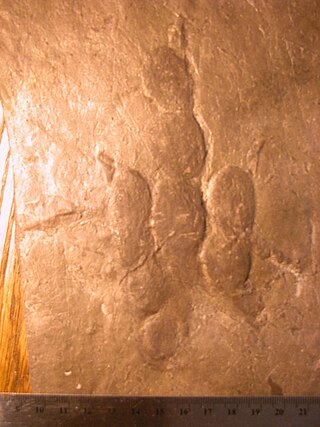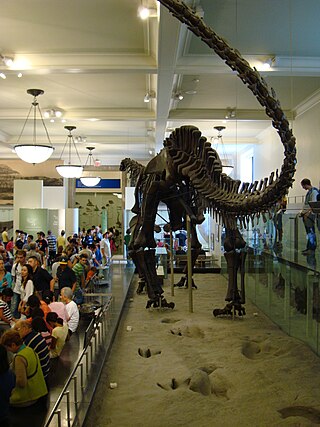
Azendohsaurus is an extinct genus of herbivorous archosauromorph reptile from roughly the late Middle to early Late Triassic Period of Morocco and Madagascar. The type species, Azendohsaurus laaroussii, was described and named by Jean-Michel Dutuit in 1972 based on partial jaw fragments and some teeth from Morocco. A second species from Madagascar, A. madagaskarensis, was first described in 2010 by John J. Flynn and colleagues from a multitude of specimens representing almost the entire skeleton. The generic name "Azendoh lizard" is for the village of Azendoh, a local village near where it was first discovered in the Atlas Mountains. It was a bulky quadruped that unlike other early archosauromorphs had a relatively short tail and robust limbs that were held in an odd mix of sprawled hind limbs and raised forelimbs. It had a long neck and a proportionately small head with remarkably sauropod-like jaws and teeth.

Grallator ["GRA-luh-tor"] is an ichnogenus which covers a common type of small, three-toed print made by a variety of bipedal theropod dinosaurs. Grallator-type footprints have been found in formations dating from the Early Triassic through to the early Cretaceous periods. They are found in the United States, Canada, Europe, Australia, Brazil and China, but are most abundant on the east coast of North America, especially the Triassic and Early Jurassic formations of the northern part of the Newark Supergroup. The name Grallator translates into "stilt walker", although the actual length and form of the trackmaking legs varied by species, usually unidentified. The related term "Grallae" is an ancient name for the presumed group of long-legged wading birds, such as storks and herons. These footprints were given this name by their discoverer, Edward Hitchcock, in 1858.

Lagerpeton is a genus of lagerpetid avemetatarsalian, comprising a single species, L. chanarensis. First described from the Chañares Formation of Argentina by A. S. Romer in 1971, Lagerpeton's anatomy is somewhat incompletely known, with fossil specimens accounting for the pelvic girdle, hindlimbs, posterior presacral, sacral and anterior caudal vertebrae. Skull and shoulder material has also been described.

A fossil track or ichnite is a fossilized footprint. This is a type of trace fossil. A fossil trackway is a sequence of fossil tracks left by a single organism. Over the years, many ichnites have been found, around the world, giving important clues about the behaviour of the animals that made them. For instance, multiple ichnites of a single species, close together, suggest 'herd' or 'pack' behaviour of that species.

Heterodontosauridae is a family of ornithischian dinosaurs that were likely among the most basal (primitive) members of the group. Their phylogenetic placement is uncertain but they are most commonly found to be primitive, outside of the group Genasauria. Although their fossils are relatively rare and their group small in numbers, they have been found on all continents except Australia and Antarctica, with a range spanning the Early Jurassic to the Early Cretaceous.

The Pekin Formation is a Late Triassic (Carnian) geological formation in North Carolina. The Pekin Formation is specific to the Sanford Sub-Basin of the Deep River Basin of North Carolina, although it may be equivalent to the Stockton Formation of Pennsylvania, New Jersey, and New York. The Pekin Formation was deposited in a rift basin along the Atlantic margin of North America during the breakup of the supercontinent Pangaea during the Late Triassic. The most common rocks in the Pekin Formation are red to brown sandstones, representing a terrestrial fluvial (riverine) and floodplain environment in a hot, humid climate. It has yielded both abundant plant and animal fossils, including some of the oldest potential dinosaur footprints in the world and the large predatory crocodylomorph Carnufex carolinensis.

Chanaresuchus is an extinct genus of proterochampsid archosauriform. It was of modest size for a proterochampsian, being on average just over a meter in length. The type species species is Chanaresuchus bonapartei was named in 1971. Its fossils were found in from the early Carnian-age Chañares Formation in La Rioja Province, Argentina. Chanaresuchus appears to be one of the most common archosauriforms from the Chañares Formation due to the abundance of specimens referred to the genus. Much of the material has been found by the La Plata-Harvard expedition of 1964-65. Chanaresuchus is the most well-described proterochampsid in the subfamily Rhadinosuchinae.

Stegomosuchus is an extinct genus of small protosuchian crocodylomorph. It is known from a single incomplete specimen discovered in the late 19th century in Lower Jurassic rocks of south-central Massachusetts, United States. It was originally thought to be a species of Stegomus, an aetosaur, but was eventually shown to be related to Protosuchus and thus closer to the ancestry of crocodilians. Stegomosuchus is also regarded as a candidate for the maker of at least some of the tracks named Batrachopus in the Connecticut River Valley.
Kayentavenator is a genus of small carnivorous tetanuran dinosaur that lived during the Early Jurassic Period; fossils were recovered from the Kayenta Formation of northeastern Arizona and were described in 2010.
Prorotodactylus is a dinosauromorph or pterosauromorph ichnogenus known from fossilized footprints found in Poland and France. The prints may have been made by a dinosauromorph that was a precursor to the dinosaurs, possibly closely related to Lagerpeton. Fossils of Prorotodactylus date back to the early Olenekian stage of the Early Triassic, making it the oldest known dinosauromorph. Its presence during this time extends the range of the dinosaur stem lineage to the start of the Early Triassic, soon after the Permian-Triassic extinction event. Prorotodactylus is the only ichnogenus within the ichnofamily Prorotodactylidae. Two ichnospecies are known, the type P. mirus and P. lutevensis.

Reptiles arose about 320 million years ago during the Carboniferous period. Reptiles, in the traditional sense of the term, are defined as animals that have scales or scutes, lay land-based hard-shelled eggs, and possess ectothermic metabolisms. So defined, the group is paraphyletic, excluding endothermic animals like birds that are descended from early traditionally-defined reptiles. A definition in accordance with phylogenetic nomenclature, which rejects paraphyletic groups, includes birds while excluding mammals and their synapsid ancestors. So defined, Reptilia is identical to Sauropsida.

Paleontology in Pennsylvania refers to paleontological research occurring within or conducted by people from the U.S. state of Pennsylvania. The geologic column of Pennsylvania spans from the Precambrian to Quaternary. During the early part of the Paleozoic, Pennsylvania was submerged by a warm, shallow sea. This sea would come to be inhabited by creatures like brachiopods, bryozoans, crinoids, graptolites, and trilobites. The armored fish Palaeaspis appeared during the Silurian. By the Devonian the state was home to other kinds of fishes. On land, some of the world's oldest tetrapods left behind footprints that would later fossilize. Some of Pennsylvania's most important fossil finds were made in the state's Devonian rocks. Carboniferous Pennsylvania was a swampy environment covered by a wide variety of plants. The latter half of the period was called the Pennsylvanian in honor of the state's rich contemporary rock record. By the end of the Paleozoic the state was no longer so swampy. During the Mesozoic the state was home to dinosaurs and other kinds of reptiles, who left behind fossil footprints. Little is known about the early to mid Cenozoic of Pennsylvania, but during the Ice Age it seemed to have a tundra-like environment. Local Delaware people used to smoke mixtures of fossil bones and tobacco for good luck and to have wishes granted. By the late 1800s Pennsylvania was the site of formal scientific investigation of fossils. Around this time Hadrosaurus foulkii of neighboring New Jersey became the first mounted dinosaur skeleton exhibit at the Academy of Natural Sciences in Philadelphia. The Devonian trilobite Phacops rana is the Pennsylvania state fossil.
The Sloan Canyon Formation is a late Triassic geologic formation exposed in northeastern New Mexico. Fossil theropod tracks have been reported from the formation.
The Sheep Pen Sandstone is a late Triassic geologic formation exposed in northeastern New Mexico. Fossil theropod tracks have been reported from the formation.

The 20th century in ichnology refers to advances made between the years 1900 and 1999 in the scientific study of trace fossils, the preserved record of the behavior and physiological processes of ancient life forms, especially fossil footprints. Significant fossil trackway discoveries began almost immediately after the start of the 20th century with the 1900 discovery at Ipolytarnoc, Hungary of a wide variety of bird and mammal footprints left behind during the early Miocene. Not long after, fossil Iguanodon footprints were discovered in Sussex, England, a discovery that probably served as the inspiration for Sir Arthur Conan Doyle's The Lost World.

Pentasaurus is an extinct genus of dicynodont of the family Stahleckeriidae, closely related to the well known Placerias. It was found in the Lower Elliot Formation of South Africa, dated to the Norian of the Late Triassic period. The genus contains the type and only species, Pentasaurus goggai. Pentasaurus is named after the ichnogenus Pentasauropus, fossil footprints that were originally described from the lower Elliot Formation in 1970 decades before the body fossils of Pentasaurus itself were recognised. Pentasauropus footprints were likely made by dicynodonts, and in South Africa Pentasaurus itself was the likely trackmaker. The name reflects the fact that a large dicynodont was predicted to have existed in the lower Elliot Formation before any body fossils were recognised, and so Pentasaurus was named after its probable footprints. This is a reversal of the more typical occurrence where fossil footprints are named after their presumed trackmakers. The name of the species honours its collector Alfred Brown, nicknamed "Gogga", which means "bug" in Afrikaans.
Gwyneddichnium is an ichnogenus from the Late Triassic of North America and Europe. It represents a form of reptile footprints and trackways, likely produced by small tanystropheids such as Tanytrachelos. Gwyneddichnium includes a single species, Gwyneddichnium major. Two other proposed species, G. elongatum and G. minore, are indistinguishable from G. major apart from their smaller size and minor taphonomic discrepancies. As a result, they are considered junior synonyms of G. major.

Protochirotherium, also known as Protocheirotherium, is a Late Permian?-Early Triassic ichnotaxon consisting of five-fingered (pentadactyl) footprints and whole tracks, discovered in Germany and later Morocco, Poland and possibly also Italy. The type ichnospecies is P. wolfhagenense, discovered by R. Kunz in 1999 alongside Chirotherium tracks, was named and described in 2004 and re-evaluated in 2007; a second ichnospecies, P. hauboldi, also exists, which was initially described as an ichnospecies of Brachychirotherium. Protochirotherium-like prints have also been documented from the Late Permian of Italy, possibly representing the oldest known fossils of mesaxonic archosauromorphs.
Rhynchosauroides is an ichnogenus, a form taxon based on footprints. The organism producing the footprints was likely a lepidosaur and may have been a sphenodont, an ancestor of the modern tuatara. The footprint consists of five digits, of which the fifth is shortened and the first highly shortened.
Batrachichnus is an amphibian ichnogenus commonly found in assemblages of ichnofossils dating to the Mississippian to Triassic of North America, South America, and Europe. The animal producing the tracks was likely a temnospondyl. B. slamandroides is the smallest known tetrapod footprint, produced by an animal with an estimated body length of just 8 millimeters (0.31 in)













